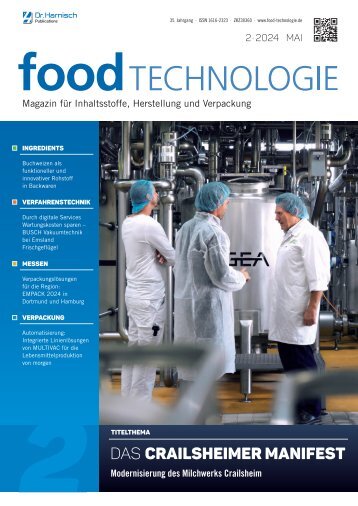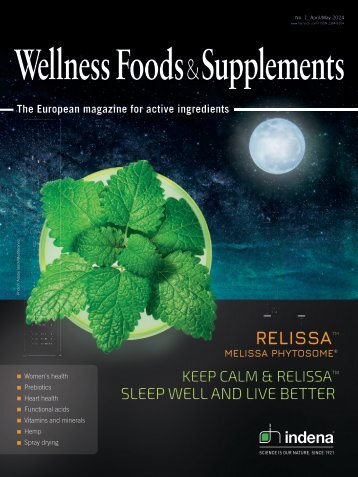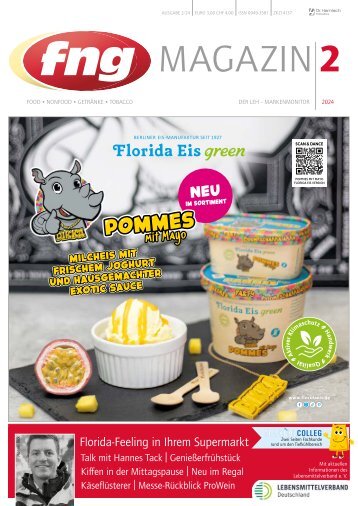Wellness Foods & Supplements 3/2020
- Text
- Harnischcom
- Supplements
- Foods
- Wellness
- Clinical
- Salts
- Protein
- Dairy
- Vaginal
- Products
- Yogurt
- Mineral
- Calcium
- Magnesium
Oils and fats Photo © :
Oils and fats Photo © : 123rf/jirkaejc Keeping omega-3 oils safe, pure and taste-neutral Frank Möllering With the growing awareness of the health benefits of omega-3 unsaturated fatty acids, demand for supplements, fortified foods and enriched beverages is rising. High-quality vegetable and microalgae-derived oils are particularly popular, but consumers are still sceptical about omega-3 products containing fish oil. Straight away, “fishy” smelling and tasting capsules come to mind. Yet, there are methods and processes available that refineries can use to supply highpurity oils that are absolutely neutral in terms of sensory properties. Although the number of people who still abide by the old dietary recommendation of eating fish at least once a week is declining, there is increasing evidence to illustrate just how important omega-3 fatty acids are for our minds and bodies. For a long time, fatty fish and seafood such as mussels were said to be the most important sources; now, however, a huge array of dietary supplements are available on the market, and a growing number of foodstuffs and beverages are enriched with essential fatty acids. Fish is still a popular source of oil, but it’s a challenging material to process: it oxidises quickly and, like any crude oil of plant or animal origin, can become contaminated during cultivation or transport. Additionally, fish oil poses the greatest challenge in terms of neutralising its fishy odour and taste. Nutriswiss, a small refinery that specialises in purifying and modifying high-quality edible oils, has been processing fish oil for many years. Keeping a close eye on market developments at the same time, this Swiss company is well aware of the plant-based trend and now processes just as much algal oil as fish oil. 6 No. 3 November/December 2020
Oils and fats Growing demand for health and wellness To ensure a sufficient supply of essential fatty acids, alternatives to fish oil are in demand. In recent years, vegetable sources such as nuts, seeds and oils (such as rapeseed) have become increasingly popular; chia and linseed are frequently used as toppings in healthy bowls or shakes, for example. Compared with marine sources, they mainly contain the omega-3 fatty acid, ALA (alphalinolenic acid), which must be converted by human metabolism to DHA (docosahexaenoic acid) and EPA (eicosapentaenoic acid). As this is only partially possible and an inefficient process, the required intake is much higher. Long-chain omega-3 fatty acids play an important role in brain growth and development, blood pressure regulation, kidney function, blood clotting and numerous inflammatory and immunological reactions. A recent study showed that omega-3s can protect the brain from the damage caused by inhaled particulate matter. 1 As a component of cell membranes, the unsaturated fatty acids in breast milk, especially DHA, are important for healthy eye and brain development, particularly during the first two years of life. And as the body of scientific proof expands, so too do the regulatory requirements: DHA must now be present at a concentration of 20–50 mg per 100 kcal in any infant formula that’s to be sold in the EU. 2 smell). But, it’s not just sensory properties that make a good omega-3 oil, purity is also crucial. The higher the proportion of unsaturated fatty acids in a raw oil, the more carefully it needs to be handled. On one hand, both the crude and refined oils must be protected and kept within a controlled atmosphere; on the other, it means that harsh refining environments need to be avoided. The chemical structures of omega-3 fatty acids contain several double bonds, which is why they react very quickly. For sources with extremely high omega-3 contents, such as tuna oil, which contains 25 % DHA, the oxidation potential is correspondingly high. It is too unstable to be refined in the same way that rapeseed or soy oil is, for example. At the same time, though, any contaminants that are harmful to health must be refined out to comply with food safety standards. Microalgae Many companies have now realised that microalgae can serve as a sustainable alternative raw material: they are relatively easy to cultivate and reproduce quickly (Fig. 1). For instance, the food industry considers them to be a productive marine source of omega-3. As they comprise up to 50 % fat, refining the raw oil is very efficient and, almost as importantly, they contain EPA and even more DHA than tuna oil. Fish does, too, but they get it from consuming algae — so why not start directly at the source? In addition, algae cultures are more environmentally friendly and protect fish stocks. Although the microalgae market is still in the discovery phase, growers and refiners such as Nutriswiss are already ahead of the curve and are driving further research and product development with algae oil. Sensory properties correlate with quality Optimising the sensory properties of omega-3 oils means more than just consumer acceptance; unpleasant off notes and a bad odour are symptoms of a decaying product. At Nutriswiss, a comprehen- High risk of oxidation Once the extracted oils are microencapsulated or powdered, the valuable fatty acids are completely isolated, which makes further decomposition reactions less likely. Most food operators understand that when handling oils containing polyunsaturated fatty acids, an oxidation reaction takes place when they come into contact with oxygen in the ambient air, which induces decomposition. The consequences clearly manifest themselves as off notes, an unappealing taste and a dark colour (mainly because of the formation of ketones and aldehydes that are responsible for that all-too-familiar fishy Fig.1: In the food and nutraceuticals industry, and beyond, microalgae are the new all-rounders. (Photo © : 123rf/Akhararat Wathanasing) No. 3 November/December 2020 7
- Seite 1: No. 3, November/December 2020 www.h
- Seite 4 und 5: Contents Health Convenience Food Fo
- Seite 8 und 9: Oils and fats sive “key figure”
- Seite 10 und 11: Functional sugars Photo © : Jennew
- Seite 12 und 13: Nutrition and ageing Photo © : Ado
- Seite 14 und 15: Nutrition and ageing demineralizati
- Seite 16 und 17: Nutrition and ageing Proferrin ® ,
- Seite 18 und 19: Energy and endurance system is conn
- Seite 20 und 21: Minerals Photo ® : Adobe Stock/nd3
- Seite 22 und 23: Minerals Health Claims Magnesium co
- Seite 24 und 25: Women‘s health Probiotics for wom
- Seite 26 und 27: Women‘s health How can oral probi
- Seite 28 und 29: Clinical trials Photo ® : Adobe St
- Seite 30 und 31: Clinical trials methods; and the sa
- Seite 32 und 33: Fortified dairy alternatives Minera
- Seite 34 und 35: Fortified dairy alternatives Dairy
- Seite 36 und 37: Fortified dairy alternatives theref
- Seite 38 und 39: Fortified dairy alternatives instea
- Seite 40 und 41: Dairy products lactose digestion”
- Seite 42 und 43: Dairy products EPILAC premium yogur
- Seite 44: Come and see for yourself: www.harn
Unangemessen
Laden...
Magazin per E-Mail verschicken
Laden...
Einbetten
Laden...




























































































































































































































































































